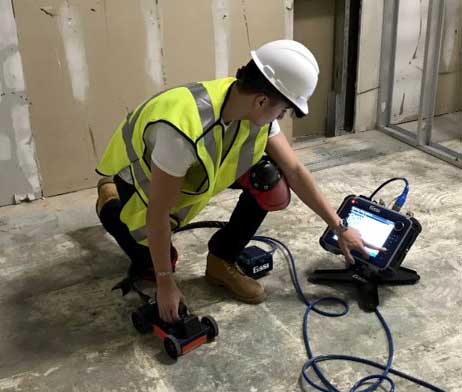The Importance of Professional Concrete Scanning Solutions
Wiki Article
Past the Surface: Leveraging Advanced Concrete Scanning Techniques for Unmatched Accuracy and Understanding
Advanced concrete scanning techniques have actually emerged as vital devices in this search, using a glance below the surface to reveal a globe of important understandings. By utilizing sophisticated technologies, experts can reveal anomalies, evaluate the problem of concrete frameworks, and make notified choices that form the course of jobs.Relevance of Advanced Concrete Scanning
The importance of using innovative concrete scanning methods exists in the unrivaled precision they supply for discovering sub-surface abnormalities and ensuring structural stability. By using cutting-edge innovations such as ground-penetrating radar (GPR), electro-magnetic induction, and progressed finder imaging, construction experts can delve below the surface area of concrete structures with a degree of precision that far goes beyond traditional evaluation techniques. Concrete Scanning. These methods enable the identification of covert dangers like rebar corrosion, gaps, avenues, or post-tension cables that can endanger the stability and safety of a framework in timeFurthermore, advanced concrete scanning provides indispensable insights into the general problem of a concrete element without the requirement for invasive actions, decreasing the threat of triggering damages during the assessment procedure. The capability to determine the precise area and deepness of possible concerns permits for targeted repairs and maintenance, inevitably extending the life expectancy of the structure and optimizing its performance. In significance, the relevance of advanced concrete scanning can not be overstated in the realm of construction and infrastructure upkeep, where accuracy and integrity are critical.
Types of Cutting-Edge Technologies

Abnormalities and Defect Discovery

In enhancement to GPR, concrete scanning techniques like thermography and impact-echo testing are likewise reliable in spotting abnormalities and defects. Thermography makes use of infrared modern technology to recognize variations in surface temperature, indicating prospective locations of problem such as delamination or moisture ingress. On the other hand, impact-echo screening entails assessing acoustic reactions to find voids, read this cracks, and other problems within the concrete. By leveraging these innovative techniques, specialists can proactively deal with structural problems, ensuring the longevity and safety of concrete frameworks.
Assessing Concrete Condition
How can designers precisely examine the problem of concrete frameworks to guarantee their longevity and safety and security? Analyzing the concrete condition is a crucial facet of maintaining infrastructure stability. Numerous innovative concrete scanning strategies are utilized for this objective. Ground-penetrating radar (GPR) is commonly made use of to evaluate the inner structure of concrete, click for more detecting gaps, cracks, and various other anomalies that may endanger its stamina. In addition, impact-echo testing can give insights right into the density and stability of concrete components. Ultrasonic pulse velocity testing is another important approach for assessing concrete high quality by determining the rate of acoustic waves with the product.Integrating non-destructive screening techniques with aesthetic examinations permits for a thorough evaluation of concrete condition, allowing engineers to determine prospective problems early on and carry out prompt maintenance or repair services. By leveraging these innovative techniques, engineers can make sure the long-term sturdiness and safety and security of concrete frameworks.
Enhancing Decision-Making Processes
In the world of infrastructure administration, maximizing decision-making processes is necessary for guaranteeing the effective upkeep and longevity of concrete structures. Enhanced decision-making procedures in concrete management include using advanced scanning techniques to gather detailed data on the problem of structures. By leveraging modern technologies such as ground-penetrating radar and 3D imaging, stakeholders find more information can make educated choices relating to reinforcement, repair service, or substitute strategies.These advanced scanning methods supply important insights right into the internal composition of concrete, determining potential issues such as voids, cracks, or deterioration that may not be noticeable on the surface. This level of thorough info allows for proactive upkeep planning, minimizing the danger of structural failures and enhancing the general lifespan of concrete frameworks.
Additionally, by including electronic documentation and evaluation tools into the decision-making procedure, stakeholders can track the evolution of concrete conditions in time, making it possible for predictive upkeep strategies and maximizing resource allocation. Ultimately, the combination of advanced concrete scanning techniques enhances decision-making processes by offering unrivaled precision, understanding, and efficiency in facilities management.
Verdict
Finally, progressed concrete scanning techniques use exceptional precision and insight in finding anomalies, defects, and assessing the problem of concrete frameworks. By leveraging advanced technologies, decision-making procedures can be improved, causing more informed and efficient options for keeping and repairing concrete infrastructure. These techniques play an essential role in making certain the safety and security and longevity of concrete frameworks, making them an important device in the area of building and construction and design.In addition, advanced concrete scanning supplies vital insights right into the total problem of a concrete element without the need for invasive measures, minimizing the danger of causing damages during the evaluation procedure - Concrete Scanning. One more innovative innovation is 3D X-ray scanning, which provides thorough photos of the interior framework of concrete, using important info without the demand for destructive screening. Furthermore, Concrete Cover Meters are used to measure the thickness of concrete cover over support bars accurately. Improved decision-making procedures in concrete monitoring entail using advanced scanning techniques to gather in-depth data on the problem of frameworks.In final thought, progressed concrete scanning techniques offer exceptional accuracy and understanding in finding abnormalities, defects, and evaluating the condition of concrete structures
Report this wiki page